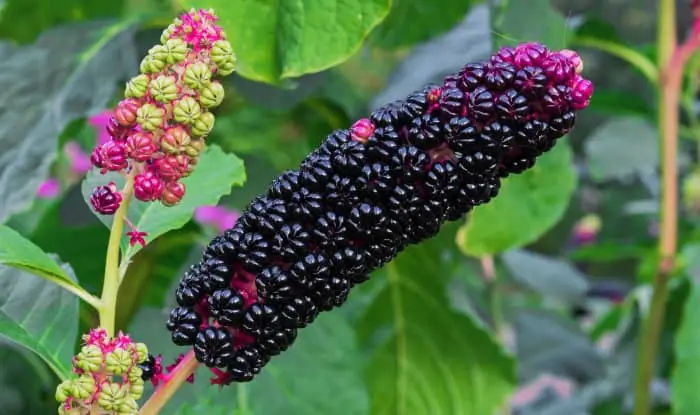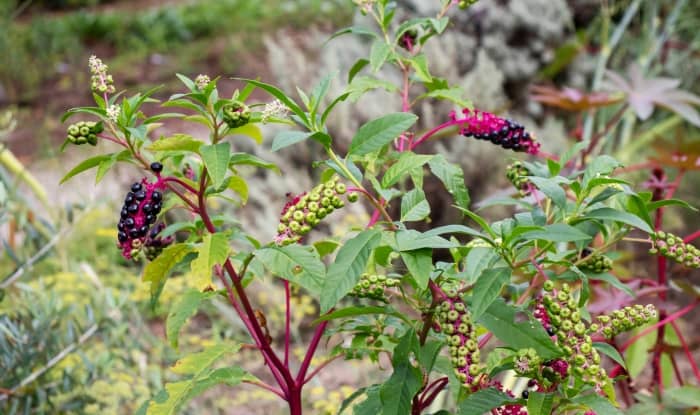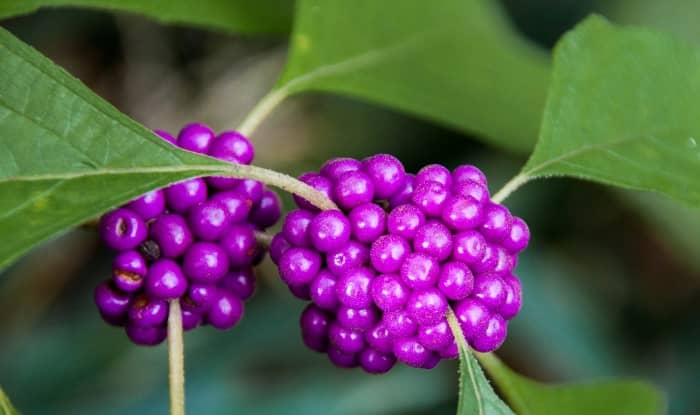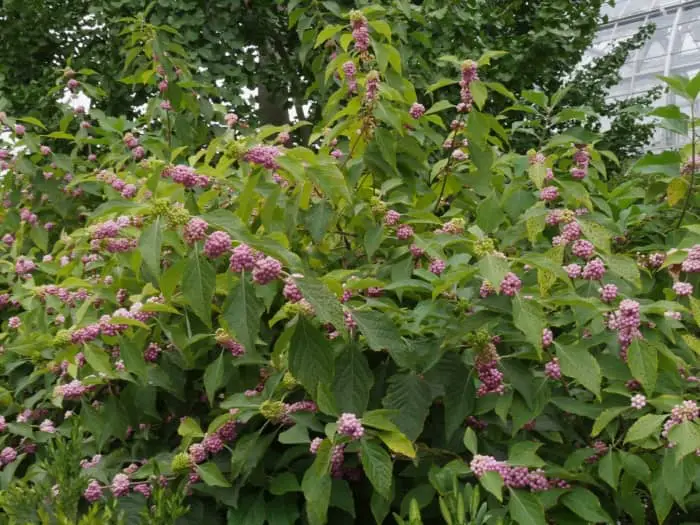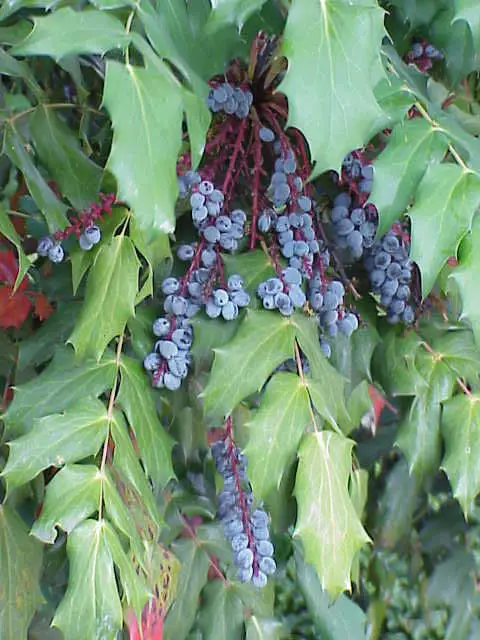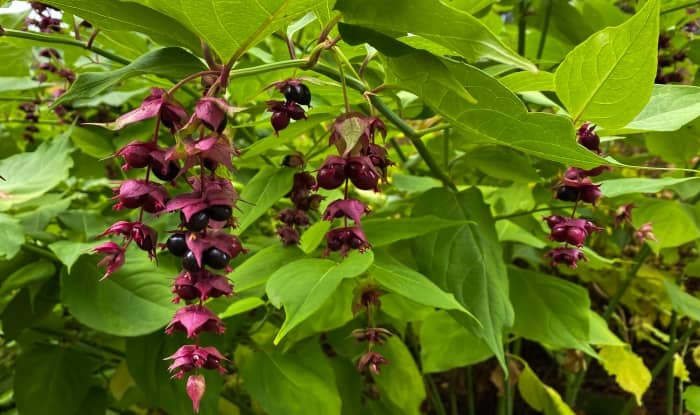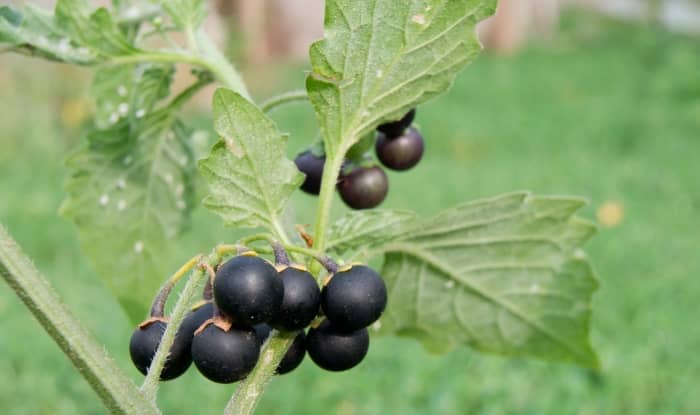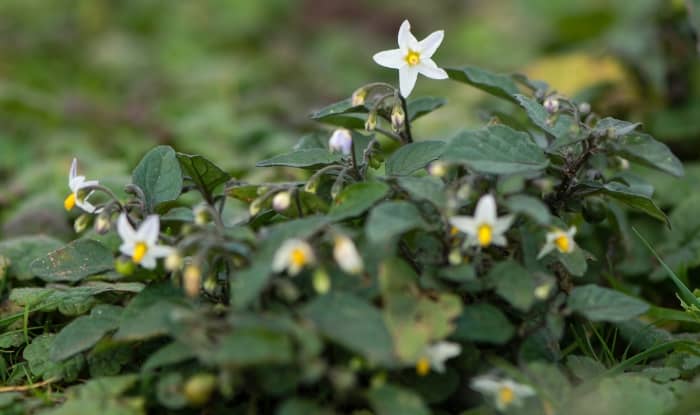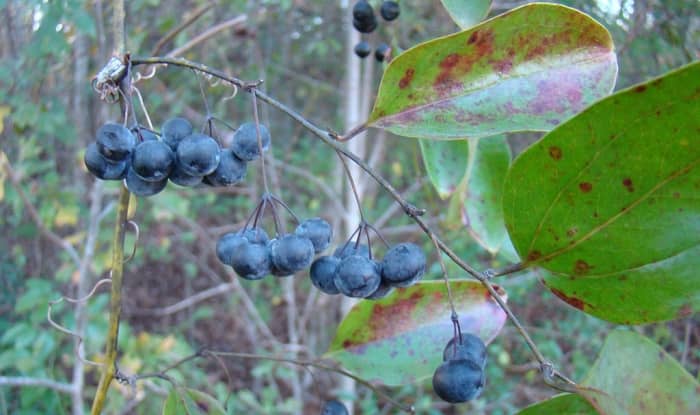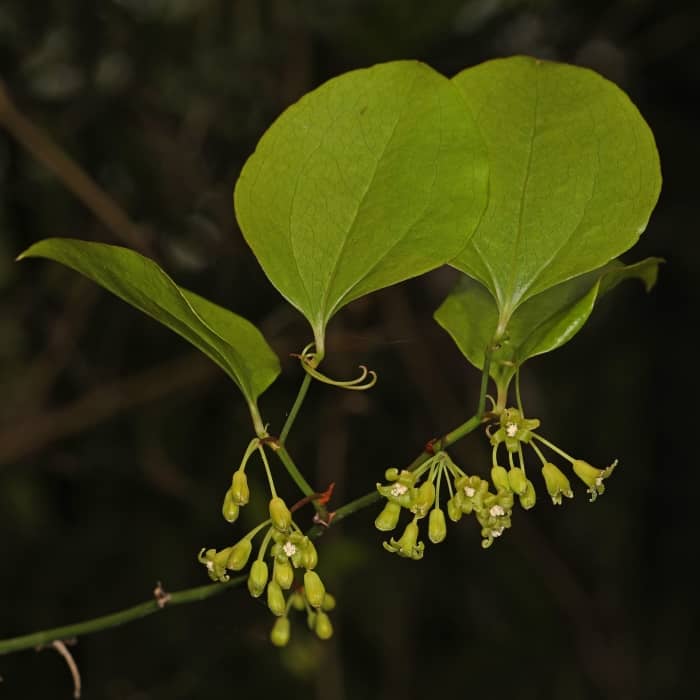Have you found weeds with purple berries growing around your yard?
We’ll help you identify the weeds using photos and detailed descriptions.
Let’s dive in.
Weeds With Purple Berries
The most common weeds with purple berries are highly distinctive and easy to recognize.
Here are the weeds you’re most likely to come across:
Pokeweed (Phytolacca Americana)
Pokeweed is a large and problematic perennial broadleaf weed. Pokeweed is an invasive weed because it can spread rapidly in an area, growing in dense, tall bushes that crowd out and displace other plants.
You can easily identify pokeweed when it bears fruit. Pokeweed has attractive, dark-purple berries that are tempting to eat, but make sure you don’t. Pokeweed berries are poisonous.
The fruit contains seeds that help the weed to spread. So even if you don’t remove the pokeberry plant, it’s worth removing the fruit, especially if you have young children who might put the berries in their mouths.
When pokeweed isn’t producing fruit, you can recognize the weed by its thick hollow red stems, green-white flowers, and large green leaves with long petioles.
American Beautyberry (Callicarpa americana)
Also known as French mulberry, this weed bush with purple berries is used as an ornamental by some people and is particularly eye-catching in the fall when the berries ripen.
You’ll also find American beautyberry growing wild along roadsides and in the pine flatwoods of Florida.
The shrub grows up to 8 feet tall with 20cm long ovate to elliptical leaves. The leaves are yellow-green, toothed at the margins, and have a hairy/velvety texture.
In spring, American beautyberry produces clusters of small white, violet, or pink colored flowers around the stem at the leaf apex. The flowers eventually form small purple berries in early to mid-autumn.
Leatherleaf Mahonia (Mahonia bealei)
MAHONIA BEALEI BY KURT STUBER, CC BY SA 3.0, VIA WIKIMEDIA COMMONS
Also known as Beale’s barberry, leatherleaf mahonia is originally from China but has naturalized in many parts of the United States. It can be problematic, with some states listing it as a noxious and invasive weed.
Leatherleaf mahonia is an evergreen shrub that usually grows from 5-10 ft. in height. The plant has large pinnately compound leaves that grow up to 18-inches long. The leaves consist of 9-13 holly-like leaflets, 2-4 inches long and 1-2 inches wide. Like holly, the leaves are thick, waxy, and spiky at the edges, so be careful when handling the plant or brushing against it.
The weed produces fragrant, lemon-yellow flowers from late winter to early spring. From around late April to early May, the plant sets fruit, producing berries that initially look green but ripen to a dark purple with a greyish-blue waxy bloom covering. The berries grow in string-like racemes from red stems and look similar to grapes, growing to about an inch long.
The purple berries on this weed are edible raw, or you can use them to make jelly, pies, or wine (1). But, eating too many raw berries has been known to cause digestive problems.
Leatherleaf mahonia is a large weed that grows in a range of soil types and likes sunny conditions. But the weed can also grow in somewhat shady locations that many plants struggle in. You’ll often find this weed growing in woodlands in the southern United States.
Himalayan Honeysuckle (Leycesteria formosa)
As the name suggests, Himalayan honeysuckle is native to the Himalayas. It’s a tall weed that grows aggressively in dense thickets, making it difficult to remove. And the weed is considered noxious and invasive in some regions, particularly parts of New Zealand and Australia (2).
Himalayan honeysuckle is a perennial shrub that grows up to 6 ft. tall. When young, the stems are green and hollow but turn woody as the plant ages, with large heart-shaped leaves growing in opposite pairs from stalks.
Drooping spikes of white flowers grow at the end of the stems. The flowers are funnel-shaped and have reddish-purple bracts. From December to May, the weed produces purple berries that are juicy and measure 7-10 mm in diameter.
Virginia Creeper (Parthenocissus quinquefolia)
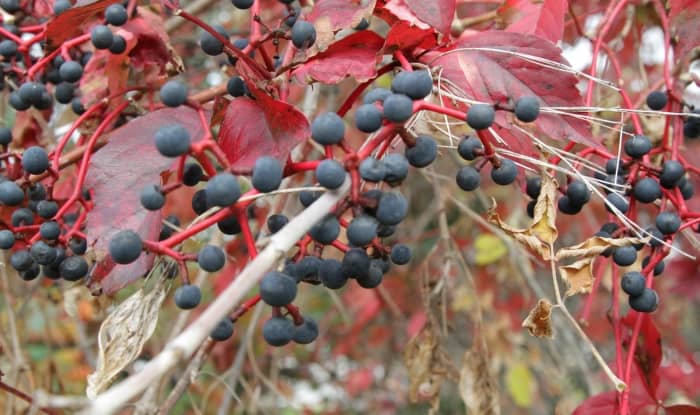
Virginia creeper is a perennial woody vine weed with black-purple berries often found around orchards, vineyards, and gardens.
Virginia creeper is a fast-growing vine sometimes mistaken for poison ivy. But unlike poison ivy, Virginia creeper has five leaflets making up its compound leaves that taper to a pointed tip with saw-toothed edges. And Virginia creeper doesn’t produce urushiol oil, the skin irritant that makes poison ivy notorious. But it does produce sap that causes a skin rash in highly-sensitive people.

Virginia creeper grows well in full sun to full shade and can climb up to 30 ft. with adhesive pads at the end of tendrils holding the vine in place. When Virginia creeper blooms, it produces clusters of yellow flowers at the end of green-red stalks.
In the fall, Virginia creeper leaves turn red, and the flowers give way to dark black-purple berries at the end of the now bright red stalks. The berries are poisonous, so don’t eat them. But every part of the plant is toxic, containing oxalate crystals. In particular, the seeds, seed pods, and leaves have high oxalate crystal levels.
Black Nightshade (Solanum nigrum, Solanum ptycanthum, Solanum americanum)
There are three closely related plants called black nightshade (3) in North America, sharing similar characteristics:
- European black nightshade (Solanum nigrum), also called blackberry nightshade, is native to Eurasia and an introduced species in other parts of the world.
- American black nightshade (Solanum americanum), also called glossy nightshade, is native to the Americas, Melanesia, and Australia.
- Eastern black nightshade (Solanum ptychanthum), also called West Indian black nightshade, is native to North America. This weed grows in all US states apart from Oregon, Nevada, California, and Washington State. You can also find it growing in the southern provinces of Canada.
The black nightshades are broadleaf annual weeds with small black-purple berries that grow in clusters. The weeds have leaves that grow alternately on short stalks.
Some strains of black nightshade are poisonous plants, while others are edible weeds. The plants also resemble deadly nightshade, so unless you know what you’re doing, make sure you don’t eat the juicy berries or other parts of the plant.
Black nightshade is also sometimes confused with bittersweet nightshade, a weed with bright red berries that’s somewhat poisonous.
You’ll often find black nightshade growing in areas of rich soil including your lawn and garden. But you’re also likely to see it along roadsides, river banks, and areas of disturbed soil, such as cultivated land.
Common Greenbrier (Smilax rotundifolia)
COMMON GREENBRIER BY FRANKLIN BONNER, USFS (RET.), BUGWOOD.ORG, CC BY 3.0, VIA WIKIMEDIA COMMONS
Common greenbrier is also known as catbrier or roundleaf greenbrier. Common greenbrier is native to Eastern and South-Eastern North America, and you’ll usually see it growing in woods and forests.
This weed is identifiable by its long, woody vines with large black-tipped thorns. The vines grow up to 25 feet long, are hard like canes, and are pale green. The vines grow over the ground and climb over objects and vegetation with the help of small tendrils.
COMMON GREENBRIER BY JUDY GALLAGHER
The leaves are green, glossy, and oval-shaped, growing from the stems on petioles. Depending on the location, the plant flowers sometime from April to June, producing greenish-white flowers that grow in clusters of 3-20 flowers. In the fall, this vine weed grows black-purple berries in loose bunches that stay throughout the winter, often lasting until spring.
Reference:
- Mahonia Melange – https://www.eattheweeds.com/mahonia-melange/
- Leycesteria Formosa – https://landscapeplants.oregonstate.edu/plants/leycesteria-formosa
- Black Nightshade – https://en.wikipedia.org/wiki/Black_nightshade
